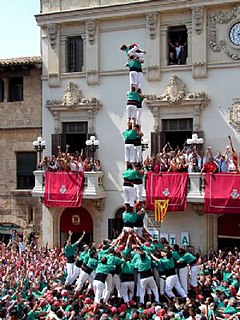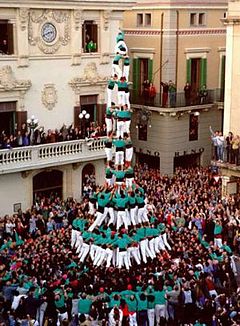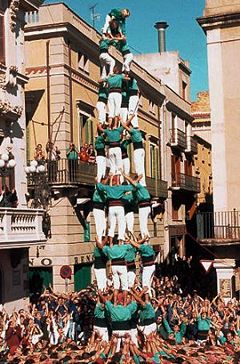This article has multiple issues. Please help improve it or discuss these issues on the talk page. (Learn how and when to remove these template messages)
|
The Castellers de Vilafranca (Catalan pronunciation: [kəstəˈʎez ðə βiləˈfɾaŋkə]) is a cultural and sporting association whose main objective is to build castells (human towers).




History edit
The Castellers de Vilafranca cultural association was founded in September 1948 by Oriol Rossell.[1] Rossell was responding to the increased interest in human tower building in Vilafranca del Penedès, a Catalan tradition that has evolved since the 18th century "Ball de Valencians", a dance from Valencia.[2][3]
The group started with seven-level towers, and forged close relationships with casteller groups in other towns. The first caps de colla (Leader/Technical Manager of the group) were Oriol Rossell (1948–1952) and Ramon Sala (1953–1955). The group originally wore rose-coloured shirts, and later red ones.
In 1956, the group became almost inactive due to internal disagreements and disputes. In 1957, it reorganized and elected to wear green shirts, which they still use today. Between 1957 and 1968, seven-level towers were the norm, and the cinc de set was the highest tower achieved. From 1969 to 1974, the group built the first towers in the eight-level category: the torre de set, quatre de vuit, tres de vuit, pilar de sis, and the torre de vuit amb folre.
In 1972, the group won the Concurs de castells de Tarragona, the Human Towers Competition held biennially in Tarragona city in the south of Catalonia. During those years, the caps de colla were Josep Pedrol (1957–1959), Carles Domènech (1960–1961), Joan Bolet (1962–1963), Gabi Martínez (1964–1969), Lluís Giménez (1970–1973) and Gabi Martínez, again (1974).
In 1975, the group underwent an internal restructure, moving away from the almost-exclusive leadership of the cap de colla, to consensual team management of the technical side of tower-building. In 1981, it was decided that team members would no longer be individually paid. This provoked a division in the group.
From 1975 to 1982, eight-level towers were performed frequently. In 1983 and 1984, the group regained its strength in this category and, in 1985, it built the first cinc de vuit. In 1987, they built the first tres and quatre de nou amb folre (carregat), and in 1989 the first completely successful tres de nou amb folre (descarregat) was achieved. In 1990, the first quatre de nou amb folre (descarregat) was built. The cap de colla between 1975 and 1994 was Carles Domènech.
Between 1995 and 2004, the highest towers were achieved: descarregats (completely and successfully dismantled), the torre de nou amb folre i manilles, pilar de set amb folre, pilar de vuit amb folre i manilles, quatre de vuit amb l’agulla, quatre de nou amb folre i l’agulla (the first one in human tower history), cinc de nou amb folre, and tres and quatre de nou amb folre built simultaneously (the first and only time in human tower history). The towers that were carregats (reached the top but collapsed afterwards) were the torre de vuit, quatre de nou, and the tres de deu amb folre i manilles (the first one in human towers history).
The group won the Tarragona Human Towers Competition in 1996, 1998, 2002, 2004,[4] 2006,[5] 2008,[6] 2010,[7][8] and 2012. In 2005, Castellers de Vilafranca achieved the torre de nou amb folre, which is considered[by whom?] the most difficult tower ever done by any group to date.
Francesc Moreno "Melilla" was the cap de colla between 1995 and 2003, and Lluís Esclassans from 2004 to 2007. David Miret was elected the new cap de colla in December 2007.
In 2010, the Castellers de Vilafranca had about 400 active human tower building members.[9]
Castells achieved edit
Castellers de Vilafranca have achieved in their history most of the constructions that have been seen in any performance. You will find below the detailed list of human constructions and the date in which they were topped or dismantled for the first time :
| CASTELL | Descarregat (successfully dismantled) |
Carregat (collapsed in dismantling) |
| Tres de nou amb folre i agulla | 31 Aug 2009 | |
| Torre de nou amb folre | 30 Aug 2005 | |
| Tres de deu amb folre i manilles | 15 Nov 1998 | |
| Quatre de nou amb folre i tres de nou amb folre simultanis | 31 Aug 2001 | |
| Torre de vuit neta | 1 Nov 2010[10] | 1 Nov 1999 |
| Quatre de nou | 1 Nov 2002 | |
| Quatre de nou amb folre i agulla | 1 Nov 1996 | 1 Nov 1995 |
| Cinc de nou amb folre | 1 Nov 1997 | 30 Aug 1997 |
| Pilar de vuit amb folre i manilles | 28 Sep 1997 | 31 Aug 1995 |
| Torre de nou amb folre i manilles | 30 Aug 1995 | |
| Tres de nou amb folre | 30 Aug 1989 | 31 Aug 1987 |
| Quatre de nou amb folre | 1 Nov 1990 | 1 Nov 1987 |
| Quatre de vuit amb l'agulla | 8 Oct 1995 | |
| Cinc de vuit | 30 Aug 1985 | |
| Torre de vuit amb folre i pilar de set amb folre simultanis | 31 Aug 2006 | |
| Pilar de set amb folre | 1 Oct 1995 | 14 May 1995 |
| Tres de vuit amb agulla | 29 Aug 1996 | |
| Dos pilars de sis simultanis (un de carregat) | 31 Aug 2001 | |
| Torre de vuit amb folre | 17 Nov 1974 | 12 Oct 1973 |
| Tres de vuit | 30 Aug 1974 | 1 Oct 1972 |
| Pilar de sis | 30 Aug 1972 | 19 Dec 1971 |
| Quatre de vuit | 30 Aug 1971 | 12 Oct 1969 |
| Nou de set | 11 Dec 1988 | |
| Torre de set | 24 Aug 1969 | |
| Tres de set aixecat per sota | 25 Nov 1973 | |
| Sis de set | 21 Jan 1997 | |
| Cinc de set amb agulla | 19 Apr 2008 | |
| Cinc de set | 26 Sep 1965 | 30 Aug 1965 |
| Tres de set amb l'agulla | 10 Aug 1996 | |
| Quatre de set amb l'agulla | 5 Aug 1954 | 31 Aug 1953 |
| Tres de set | 31 Aug 1949 | |
| Quatre de set | 31 Aug 1949 | |
| Torre de sis | 16 Jun 1949 | |
| Pilar de cinc | 14 Sep 1948 |
Cal Figarot, the group's headquarters edit
Cal Figarot is the group's headquarters. The neogothic-style building, built by August Font de Carreres at the end of the 19th century, was acquired in 1983. An adjacent warehouse was bought in 1998, and both buildings were renovated. The warehouse has an interior open space of 600 square metres. Training sessions take place in the courtyard.
Castellers de Vilafranca in the world edit
Countries where the Castellers de Vliafranca have performed include France, Italy, Lexembourg, Germany, the Netherlands, Belgium, Denmark, Chile,[11] India,[12][13] and New York City.
In 1988, they performed in Italy during the celebration of the thousandth anniversary of Catalonia. They performed in the Universal Exposition Seville'92 (1992), during the Catalonia day and in Brussels, Belgium (2010) supporting the nomination of Castells to UNESCO Heritage.[9] The Castellers de Vilafranca also performed in the opening ceremony of the XXV Olympic Games in Barcelona in 1992.
The Castellers de Vilafranca have toured extensively in the Països Catalans (territories in which the varieties of Catalan are traditionally spoken):
- Performances in Northern Catalonia: six times in Perpignan (1970, 1977, 1982, 1989, 1997 and 1998), in Toluges (1970), in Collioure (1984), in Banyuls de la Marenda (1986), three times in Vilafranca de Conflent (1985, 1988, 1989), in the Saint Michel de Cuxa monastery (1985), Prada de Conflent (1988) and in Baó, in the framework of the First meeting of the catalanitat in North Catalonia (2002).
- Four times in Andorra: in Encamp (1971), Andorra la Vella and Sant Julià de Lòria (1976), in Escaldes and again in Andorra la Vella (1983) and Escaldes (1985).
- Two tours in the Valencia Region: the first one was in Ribera del Xúquer (1979), and in the second one (1981) the group performed in Alcoi, Benidorm and Alicante. Subsequently, they performed in Carcaixent (1985), Algemesí (1993, 2000), Castellón (2000).
- One tour in Palma, Majorca (1980) and Manacor, Menorca (2001).
- One tour, already mentioned, in Alghero (1978).
Gallery edit
-
First quatre de vuit carregat by the Castellers de Vilafranca, 12/10/1969
-
First tres de nou descarregat by the Castellers de Vilafranca, 30/08/1989
-
First pilar de vuit descarregat in history, Castellers de Vilafranca, 28/09/1997
-
First torre de vuit sense folre carregada in history, Castellers de Vilafranca, 1/11/1999
-
First pilar de vuit amb folre i manilles descarregat in Barcelona, Castellers de Vilafranca, 25/09/2005
-
First torre de vuit amb folre and pilar de set amb folre descarregats simultaneously in history, Castellers de Vilafranca, 31/08/2006
-
Tres de deu amb folre i manilles by the Castellers de Vilafranca
-
Torre de set in Pisa, Castellers de Vilafranca, 1988
-
Torre de set in Paris, Castellers de Vilafranca, 1993
-
Pilar de sis in Copenhaguen, Castellers de Vilafranca, 1996
References edit
- ^ "Història dels Castellers de Vilafranca" (in Catalan).
- ^ "Photography exhibition on Catalan human towers commemorates their first anniversary as part of World Cultural Heritage". Catalan News Agency. 17 November 2011. Archived from the original on 29 July 2012.
- ^ "Close-Up: Catalonia's human towers". BBC. 14 November 2010.
- ^ "Els Castellers de Vilafranca revaliden el títol de campions del concurs de Tarragona" (in Catalan). Vilaweb. 4 October 2004.
- ^ "Els Castellers de Vilafranca s'imposen per tercer cop consecutiu en el concurs de castells de Tarragona" (in Catalan). Catalan Television. 2 October 2006.
- ^ "Els Castellers de Vilafranca revaliden el títol del concurs de Tarragona amb una actuació històrica" (in Catalan). Catalan Television. 5 October 2008.
- ^ "Els Castellers de Vilafranca tornen a fer història" (in Catalan). Vilaweb. 3 October 2010.
- ^ "Els Castellers de Vilafranca guanyen el Concurs de Castells de Tarragona després de fer tres castells de gamma extra" (in Catalan). Catalan Television. 4 October 2010.
- ^ a b "Un grupo de castellers viste con su atuendo al Manneken Pis de Bruselas" (in Spanish). La Vanguardia. 9 October 2010.
- ^ "Els Castellers de Vilafranca descarreguen la 'bèstia indomable'" (in Catalan). Vilaweb. 1 November 2010.
- ^ "Els Castellers de Vilafranca viatjaran a Xile per participar al Fòrum Universal de Cultures de Valparaíso" (in Catalan). 324.cat. 16 November 2010.
- ^ "Catalan human towers embark on an educational trip to India". Catalan News Agency. 17 August 2011. Archived from the original on 2011-09-14. Retrieved 2012-01-20.
- ^ "Los Castellers de Vilafranca, impactantes torres humanas, se presentarán este lunes en La Serena" (in Spanish). La Voz del Norte. 5 December 2010.